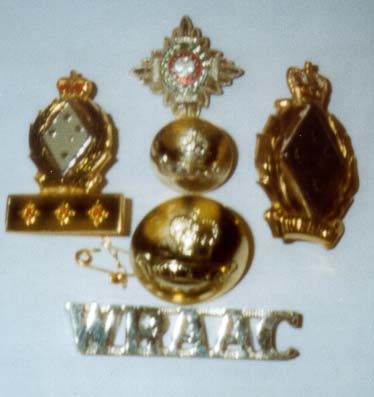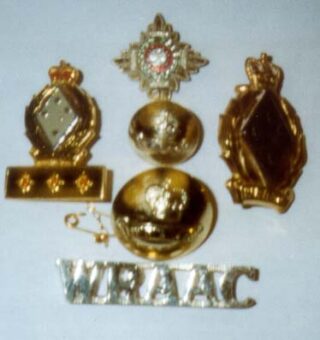- Entry type: Organisation
- Entry ID: AWE0388
Women’s Royal Australian Army Corps (WRAAC)
- Former name Womens Australian Army Corps (WAAC)

- Occupation Armed services organisation
Summary
The Women’s Royal Australian Army Corps (WRAAC) was established in April 1951 to help overcome a manpower shortage. During the late 1970s female soldiers began to be integrated into the Army at large and in early 1985, the WRAAC was disbanded. The last Officers’ Cadet School parade (6 December 1984) on the WRAAC School parade ground saw the Officer Cadets and the WRAAC Contingent marching to the strains of “Soldiers of the Queen”. Prior to the formal closing of the gates the WRAAC School flag was ceremoniously lowered and slow marched “off”, to be folded and handed over to the Chief Instructor of the WRAAC School for safe keeping. The gates, which had been repainted for the occasion, were then closed by Major Diane McVicker of the WRAAC School and Mrs Gwen Ellis – sister of Colonel Best.
The WRAAC Prayer was also included in the ceremony:
Almighty God, we ask you to reveal yourself in the fullness of your love to all who reach out to you. Help us to recognise ourselves as your children. Let the day soon dawn when we will allow your love to right every wrong.
Give us the courage and self control to play our part as members of the Women’s Royal Australian Army Corps to help your kingdom come on earth. Lead us in the pathway of life as your own wisdom and love see best: we are anxious only to do your will.
We ask you to give us the grace to rise above temptation, to be patient when tired, to be kind and helpful towards others.
To all members of our Army grant the special blessing that we need. Preserve us from selfishness. Bless every member of our Corps, our families and friends.
We come to you as children to our Father, asking these and all other blessing, in the name of Jesus Christ, Our Lord.
Amen.
Events
-
1951
WO Pat Rawlings became the first Chief Instructor for the recruit training course.
-
1951
The prefix ‘Royal’ granted by His Majestry King George VI, in recognition of the AWAS wartime service, thereby becoming Womens Royal Australian Army Corps (WRAAC).
-
1951
Approval given for the introduction of the WRAAC in to the Citizens Military Forces (CMF).
-
1952
Major Crane appointed Chief Instructor for the Officer Refresher Course. Later appointed as Chief Instructor for the Officer’s Qualifying Course held for Non-Commissioned Officers who had previously been servicewomen.
-
1951
Approval given for defining two Corps of the women’s side of the ARA. 1. RAANC and 2. WAAC.
-
1951 - 1957
Lieutenant Colonel Kathleen Best, a former matron of the AANS, commenced duty as the first Director at AHO.
-
1951 - 1961
Colonel Sybil Irving appointed as first Honorary Colonel of WAAC.
-
1951
Major Lucy Crane appointed Assistant Director of the WAAC.
-
1972 - 1977
Colonel Kathleen Fowler appointed Director of Corps.
-
1973
Honorary Colonel Sybil H Irving dies.
-
1974
Married women with children under 16 years are permitted to serve.
-
1977 - 1979
Colonel Barbara Maxwell appointed Director
-
1979
Posting of Director abolished.
-
1979 - 1981
Colonel Dulcie Verinder appointed Head of Corps.
-
1981 - 1982
Colonel Pam Smith replaces Colonel Verinder
-
1982
Lieutenant Colonel Pam Smith appointed Service Women’s Advisor to CGS.
-
1982
Colonel Margaret Fleming appointed to replace Colonel Smith.
-
1983
WRAAC members swap their buttons and badges for those of the Corps in which they served.
-
1984
Final course of Recruits and Officer Cadets march out of WRAAC School.
-
1985
WRAAC School disbanded. Female officer cadets attend OCS Portsea.
-
1985
The only member of the WRAAC to serve through the entire life of the Corps was WO2 Joyce Cole (Hogan) who retired aged 60 years. WO2 was awarded the Long Service and Good Conduct Medal, Meritorious Service Medal and the Defence Force Service Medal and Bar
-
1950
Submission made to the Military Board, with consideration being given for the reintroduction of women into the Australian Regular Army (ARA) and Citizens Military Forces (CMF)
-
1950
Cabinet approved the reintroduction of the Australian Women’s Army Service (AWAS). The Service was to be raised as an entirely separate unit, and not integrated with the male CMF.
-
1950
Approval given for the enlistment of 250 personnel.
-
1951
Decision made to discontinue AAMWS as a separate Service.
-
1959
Members of the WRAAC became eligible to contribute to the Defence Forces Retirement Benefit Fund.
-
1959
The Corps recognised as a permanent part of the Defence structure.
-
1961
Colonel Irving retires as Honorary Colonel.
-
1961 - 1966
Lieutenant Colonel May Douglas appointed Honorary Colonel.
-
1967
First detachment of WRAAC on overseas duty to Singapore. Seven WRAAC posted for 12 months service with 121 Signals Squadron.
-
1967 - 1985
Lady Helen Cutler appointed Honorary Colonel.
-
1952
Announcement that the period of engagement (3 or 6 years) and training for women would be brought in line with their male counterparts.
-
1952
Lieutenant-Colonel Best was promoted to Colonel.
-
1953 - 1985
Her Royal Highness, The Princess Margaret, C.I., G.C.V.O. appointed by Her Majesty The Queen as Colonel-in-Chief of the WRAAC.
-
1954
Queen Elizabeth 11 visited Australia. WRAAC personnel participated in events around the country.
-
1955 - 1957
Colonel Dawn Jackson appointed deputy director of WRAAC
-
1956
An alliance between the WRAAC and the Womens Royal Army Corps (WRAC), approved by Her Majestry the Queen.
-
1956
Colonel Irving reappointed as Honorary Colonel
-
1956
WRAAC and RAANC personnel participated as usherettes etc. at the Melbourne Olympic Games.
-
1957
Colonel Best died aged 47 years.
-
1958
Approval given for the adoption by the WRAAC of a Corps flag.
-
1959
The main gates at WRAAC School were designed and named in honour of Colonel Best – “the Kathleen Best Memorial Gateway”.
-
1986
Female cadets are trained at the Royal Military College Duntroon or the Australian Defence Force Academy (ADFA).
-
1980
Graduates are no longer allocated to WRAAC, but rather to the corps in which they are to serve.
-
1957 - 1972
Colonel Dawn Jackson appointed director of WRAAC
Archival resources
-
National Archives of Australia, National Office, Canberra
- Representations for grant of title of "Royal" to the Women's Australian Army corps
- [Seven slides from the opening of the Kathleen Best Memorial Gates, Women's Royal Australian Army Corps (WRAAC) School, Mosman, NSW, 6 November 1959]
- Policy and working files of the Directorate of Women's Royal Australian Army Corps (DWRAAC) of Army Headquarters/Army Office↵Policy and working files of the Directorate of Women's Royal Australian Army Corps (DWRAAC) of Army Headquarters/Army Office
- History of the Women's Royal Australian Army Corps
- Miscellaneous historical notes etc. from Women's Royal Australian Army Corps school and Women's Royal Australian Army Corps directories
- Kathleen Best Memorial (Gates) and portrait
-
National Archives of Australia, Perth Office
- Accounting stocktake - officer-in-charge's schedules [WRAAC - 14th Women's Royal Australian Army Corps]
- Training - military - general - period of CMF training [WRAAC - 14th Women's Royal Australian Army Corps]
- Displays - General WRAAC Corps Day [WRAAC - 14th Women's Royal Australian Army Corps]
- Pay and allowances CMF - general - additional training [WRAAC - 14th Women's Royal Australian Army Corps]
- Establishments and strengths - general [WRAAC - 14th Women's Royal Australian Army Corps]
- Audit reports - general - army audit reports [WRAAC - 14th Women's Royal Australian Army Corps]
- Establishments and strengths - general - CMF units [WRAAC - 14th Women's Royal Australian Army Corps]
- RAASC - supplies - expense supplies requests [RAAC - 14th Women's Royal Australian Army Corps]
- Accounting stocktake - officer-in-charge's schedules [WRAAC - 14th Women's Royal Australian Army Corps]
- National Archives of Australia, Various Locations
-
Australian War Memorial, Research Centre
- War Establishments and Amendments - [Colleges and Schools:]
- [Australian Service Canteens Organisation records:] Employment of WRAAC, [Women's Royal Australian Army Corps] ASCO [Australian Services Canteen Organisation] (Army Component)
- First WRAAC, Women's Royal Australian Army Corps
- WRAAC drill at Queenscliff training company
- Operation clean up DPR/TV/566
- WRAAC arrive in Singapore DPR/TV/743
- Two members of the Women's Royal Australian Army Corps (WRAAC), attached to the Royal Australian Survey Corps, working on topographical survey maps.
- Army Minister visits WRAAC School DPR/TV/1513
- Bomford, Janette M.(b: 1953)
- Hat badge : Womens Royal Australian Army Corps
- A pre-dinner chat for Women's Royal Australian Army Corps (WRAAC) officers
- Archbishop Daniel Mannix, Catholic Chaplain General of the Australian Army with three unidentified representatives from the Australian Army Nursing Service (AANS), Women's …
- Private Pam Armstrong of the Women's Australian Army Corps (WRAAC) 12 Company, works over a large oven by using a butterbox
- The canteen at the Australian Army Canteens Service Soldiers Club, Royal Military College, Duntroon.
- Collar badge : Womens Royal Australian Army Corps
- Australian servicewomen's memorial
- National Archives of Australia, Melbourne Office
- State Library of New South Wales
Digital resources
Published resources
- Book
-
Resource Section
- Australian Servicewomen's Memorial, Southwell-Keely, Michael, 1999, http://www.skp.com.au/memorials/pages/00018.htm
- Journal Article
- Resource
Related entries
-
Director/s
-
Related Women
-
Verinder, Dulcie Elizabeth
-
Douglas, Mary Stewart (May) (1904 - 1999)
-
Cutler, Helen Gray Annetta (1923 - 1990)
-
Rawlings, Patricia Violet May (1922 - 2009)
-
Healy, June Marie (1934 - 2020)
-
Feltham, Juanita Cecila
-
Fisher, Nora Adel (1929 - )
-
Perkins, Jessie May
-
Fisher, Mary (Marie) Gertrude (1926 - 1995)
-
Lobb, Diana Joan (Di) (1930 - 2020)
-
Irving, Sybil Howy (1897 - 1973)
-
Verinder, Dulcie Elizabeth
-
Related Organisations
-
Related Cultural Artefacts
